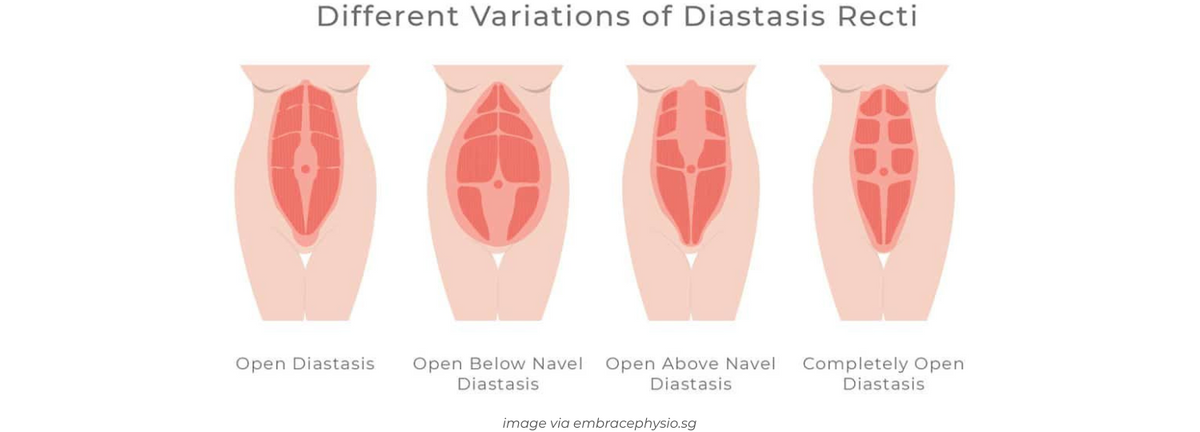There is not a “typical” case of DRA; all cases are different. Women who are highly conditioned or have no athletic background can have Diastasis Recti, as well as women of all ages and sizes.
In general, DRA prevents the core from functioning correctly. If the core is damaged and is unable to perform normal functions, one can become at risk for other health issues such as pelvic floor dysfunction and lower back pain.
“Most women seek help for a diastasis in my practice because they fear it will worsen,” shares Dr. Dawn Andalon, DPT, MTC, and CPI, and author of “Beyond Nine Months”. “Women fear activities they have heard may make DRA worse—like certain yoga poses, sit-ups, planks or twisting activities.”
However, these movements do not cause DRA and these are not the only myths surrounding this separation. With the help of Dr. Dawn, we are sharing 12 of the largest myths and truths about DRA.
MYTH #1: CARRYING A LARGE BABY OR GAINING A LOT OF WEIGHT DURING PREGNANCY WILL CAUSE DRA
There are no definitive studies proving that a large baby or a large amount of pregnancy weight, will cause DRA.
MYTH #2: LOW BACK PAIN IS A DIRECT SIGN OF DRA
Not necessarily! Low back pain can be caused by a wide variety of issues. DRA is a possibility, but it is not directly linked in all cases.
Dr. Dawn is also a featured guest in our free Mama Masterclass Series, where she delves into the intricacies of pelvic floor health and its impact on your overall well-being. Join us to unlock the keys to a more confident, active, and pain-free life. Learn more here.
MYTH #3: WORKING OUT WHILE PREGNANT WILL CAUSE DRA
Only exercises done incorrectly have been proven to make DRA worse. Staying active during your pregnancy actually helps to have a healthy pregnancy, delivery, and postpartum period. If possible, stay active within the parameters of your personal health and speak to a trained pre/postnatal fitness specialist.
PS - do you want to become a pre/postnatal fitness specialist? Learn more about our new certification process here. FIT4MOM DC is always recruiting new instructors to expand our programs to more moms. Learn more here.
MYTH #4: DRA IS CAUSED BY WEAK OR OVER-CONDITIONED CORE MUSCLES
DRA can happen to anyone at any point in any pregnancy, regardless of weakness or strength. DRA can be exacerbated by improper core work, or work that pushes the muscles further apart. However, it is not caused by core training during pregnancy. The core focus during pregnancy should be on the stability and functionality of the entire core area.
MYTH #5: MY WORKOUT SHOULDN'T CHANGE WHILE I AM PREGNANT
As your pregnancy progresses, your workouts will change to accommodate your changing body. There are movement recommendations that will keep you healthy and strong in your latter trimesters. Check out our blog “Myths about Prenatal Fitness” to learn how to adjust your workouts by trimester.
MYTH #6: IF I DIDN'T HAVE A SEVERE DRA WITH MY FIRST PREGNANCY, I WON'T HAVE ONE WITH MY SECOND.
Remember, each pregnancy is different. One instance of a mild DRA does not indicate all future pregnancies will result in the same. This is also true for severe DRA—it does not mean you are destined for a bad separation with each future pregnancy.
MYTH #7: DRA IS THE SAME FOR EVERYONE
Every body and every pregnancy is different. There are 4 different kinds of DRA and a licensed clinician can evaluate the length and width of your separation to determine your best next steps.
MYTH #8: MY DOCTOR WILL TELL ME IF I HAVE DR
Your physician may never check you for Diastasis Recti since moms typically only have 1 postnatal check-up (shocking, we know). Be your own advocate and proactively ask your doctor!
MYTH #9: ONE EXERCISE WILL FIX IT
Sure, we all wish there was a magic bullet to heal our bodies, but the truth is our core is in charge of a lot of different movements and functions. For healing, you need to slowly integrate multiple styles of movement to strengthen your core stability.
MYTH #10: SURGERY IS THE ONLY SOLUTION
You can recover without surgery, though surgery is one option. Dr. Dawn shares in her book “Beyond Nine Months,” “Avoiding an invasive surgery is definitely optimal, but some severe cases (over five finger widths of a separation at the midline) may eventually require surgery. You don’t truly know until you seek out the conservative methods first, finding a PT that specializes in treating this.”
MYTH #11: SUCKING IN MY STOMACH WILL HELP IT FLATTEN AND HEAL
Sucking your belly button to your spine can cause more damage than good! Learn proper core contraction by working with a pre/postnatal fitness professional.
MYTH #12: I CAN RESTART MY PRE-PREGNANCY WORKOUT
Go slow, mama. It is not safe to jump back into your pre-pregnancy workout. Instead, you should add on slowly, moving with the intention of rebuilding core stability, total body strength, and joint mobility. To help you learn more about how to start back with fitness after your baby, check out our blog “Movements for Moms”.
Every body is different, Mama, and this process is going to look different for every client. Even if complete recovery does not happen, a functional core is still possible! Remember to be patient with the process. It's best to slowly return to fitness and slowly progress forward when the movement is applicable, effective, and needed. You've got this, Mama.


